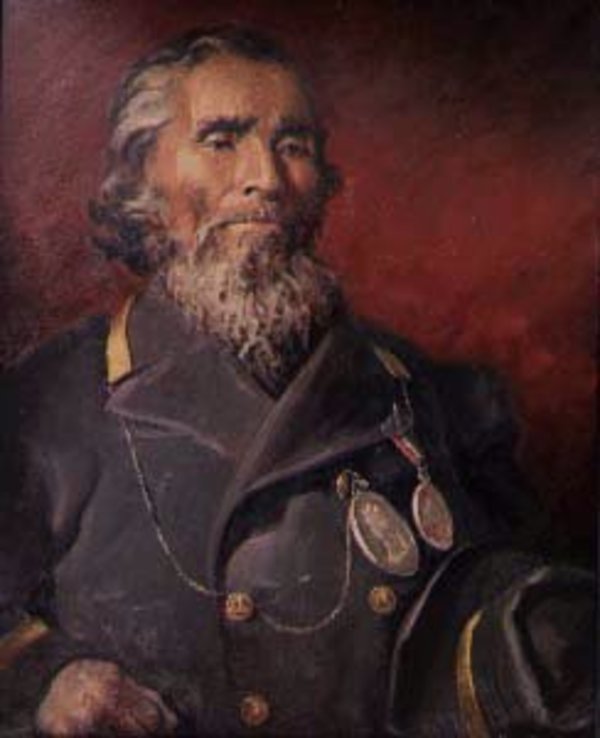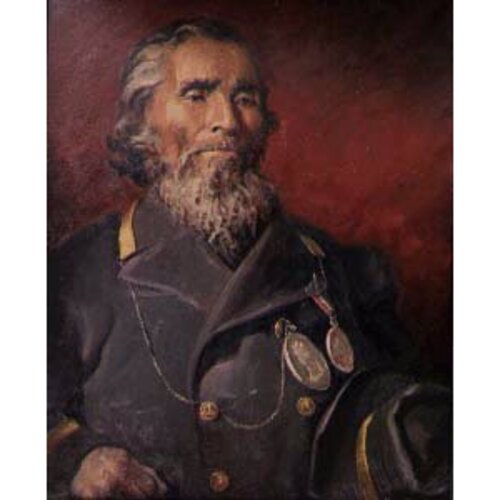
Source: Link
BERENS, JACOB (Nah-wee-kee-sick-quah-yash, Nauwigizigweas, Naawigiizhigweyaash, meaning “light moving in the centre of the sky,” believed by some to link the year of his birth to the passing of Halley’s comet in 1835), Ojibwa chief; b. c. 1832–35, probably in Berens River (Man.), son of Mahquah (Maskwa, Bear) and Amo (Bee, Victoria); m. by 1862 Mary McKay (MacKaye), and they had at least eight children; d. 7 July 1916 in Berens River.
Jacob Berens belonged to the third generation of a family which had migrated from the region of Lake Superior in the second half of the 1700s. His grandfather was Ozaawashkogaad (Yellow Legs), a widely known religious leader. Both he and Bear, Jacob’s father, conducted Midewiwin (Grand Medicine Society) and shaking tent ceremonies and were long remembered for their powers and abilities.
During Jacob’s youth, the settlement of Berens River, located at the mouth of the river of the same name on the east shore of Lake Winnipeg, was a growing crossroads of lake and river traffic. Among its visitors were Methodist missionaries stationed at Rossville, the mission founded by James Evans* in 1840 near Norway House. In August 1860 the Reverend George Millward McDougall*, stopping on his way to Rossville, recorded that the Ojibwa of Berens River were “pleading for a missionary” and that the young people “expressed themselves as willing to renounce heathenism and become Christians.” Jacob Berens was probably among them, since he was baptized at Norway House by McDougall on 25 Feb. 1861.
Methodist minister John Maclean* later stated that Berens learned the Cree syllabic writing system introduced by Evans and “laid the foundations of a successful mission among his own people.” Often during the 1860s and 1870s, however, Berens was working elsewhere. In 1869–70 he was at the Hudson’s Bay Company outpost at White Dog (Ont.) and in the summers he frequently worked on the HBC’s York boats on Lake Winnipeg. Whatever his precise role, his baptism in 1861 and the reported conversion of several others in the ten years which followed encouraged the Methodist Church to establish a mission at Berens River under the Reverend Egerton Ryerson Young* in 1873.
In 1870 Berens had settled his family at Pigeon Bay (Man.), just south of Berens River, and built one of the first log houses in the area. His son William later recollected that the family lived well on sturgeon, whitefish, wild rice, and berries. In winter they hunted caribou and rabbits and in spring beaver and muskrats, trading their furs at Berens River House, the HBC post. The children learned both Ojibwa and English from their bilingual parents and a Scots-Cree grandfather, HBC clerk William McKay, who lived with them for some years.
The family moved to Berens River at about the same time that the mission was being built. Despite his baptism, Berens did not break ties with the old ways or with his kinsmen who practised them. His father continued to hold traditional religious ceremonies at Berens River until his death in the early 1870s.
On 20 Sept. 1875 Jacob Berens was a leader in negotiating Treaty No.5 with the Canadian government. The treaty was wanted by both parties in the face of such developments as the advent of steamships on Lake Winnipeg and the arrival the next month of over 200 Icelandic settlers on the western shore of the lake. The talks with the commissioners, Lieutenant Governor Alexander Morris* and James McKay*, culminated in terms less generous than those of most of the other numbered treaties and in the election of Jacob Berens as the first treaty chief over a large area reaching up the river to Little Grand Rapids (Man.) and Pikangikum (Ont.), and up Lake Winnipeg to Poplar River (Man.), communities which later acquired their own chiefs and band status. The role brought many new responsibilities. Trips to Winnipeg to carry mail packets for the HBC now included visits to the office of the Indian Affairs branch there and discussions with officials such as Ebenezer McColl*.
In November 1876 Berens was faced with a confrontation between Canadian and Ojibwa views of crime and punishment when three young men were arrested for killing their mother. The old woman, Sawayahpunok (Streak of Daylight), believed she was becoming a windigo [see Zhauwuno-geezhigo-gaubow*]. She was shot and her body burned. The HBC officer at Berens River, Roderick Ross, who was also serving as Indian agent and magistrate, held a hearing at which Berens pleaded the sons’ case. He argued that the execution of the windigo reflected his people’s belief that “many more people would lose their lives if the woman was not killed and besides the Indians had just come into Treaty and had no chance to learn anything different.” Murder charges were not pressed.
Berens’s people faced other profound changes during his four decades as chief. Sustained commercial fishing began on Lake Winnipeg in 1883 and the following year the Indian agent at Berens River, Angus McKay*, reported the band’s concern over encroachments on their whitefish and sturgeon fisheries. In 1889 more than two million pounds of whitefish were being taken from the lake; the numbers peaked at seven and a half million pounds in 1904. Many native people, including Jacob’s son William, valued the new jobs offered by the commercial fishermen, but the harm done to subsistence fishing brought strong complaints from native communities around the lake.
With Berens’s support, Methodism gained converts at Berens River and the Reverend John Semmens* and his successors maintained a day-school. The Methodists soon had competition; in 1912, after several visits, the Oblates established a Roman Catholic mission there.
In 1909 artist Marion Hope Nelson Hooker painted a large portrait of Jacob Berens, seated, wearing his red chief’s coat and medals. Berens stayed in the Hookers’ home in Selkirk during the sitting and was remembered by the family for his “kindliness, dignity and gentlemanly bearing.”
After Berens died in July 1916, the Reverend Frederick George Stevens, summoned from Fisher River Indian Reserve, praised the old chief’s loyalty to Methodism and recorded that he died “greatly lamented by his people.” William Berens succeeded his father as chief, having acquired his knowledge of and ability to function in both the Ojibwa and the white man’s worlds. In reminiscences recorded in 1940 by American anthropologist Alfred Irving Hallowell, William expressed his father’s approach to his complex life and times with simple eloquence. “My father used to say to me, ‘Don’t think you know everything. You will see lots of new things and you will find a place in your mind for them all.’ My father was a very wise man and I have never forgotten his words.”
American Philosophical Soc. (Philadelphia), ms coll. 26 (A. I. Hallowell papers). PAM, GR 1212; HBCA, B.16/a/8: f. 15d. V. G. Berry, Vistas of promise, Manitoba, 1874–1919: November 1st, 1987–January 17th, 1988 (exhibition catalogue, Winnipeg Art Gallery, 1987). J. S. H. Brown, “‘A place in your mind for them all’: Chief William Berens,” in Being and becoming Indian: biographical studies of North American frontiers, ed. J. A. Clifton (Chicago, 1989), 204–25. A. I. Hallowell, The Ojibwa of Berens River, Manitoba: ethnography into history, ed. J. S. H. Brown (Fort Worth, Tex., and Toronto, 1992). L. C. Hewson, “A history of the Lake Winnipeg fishery for whitefish, Coregonus clupeaformis, with some reference to its economics,” Fisheries Research Board of Canada, Journal (Ottawa), 17 (1960): 625–39. J. [C.] McDougall, George Millward McDougall, the pioneer, patriot and missionary (2nd ed., Toronto, 1902). John Maclean, Vanguards of Canada (Toronto, 1918). Missionary Bull. (Toronto), 13 (1917): 37. Alexander Morris, The treaties of Canada with the Indians of Manitoba and the North-West Territories . . . (Toronto, 1880; repr. 1971). Frank Tough, “Changes to the native economy of northern Manitoba in the post-treaty period: 1870–1900,” Native Studies Rev. (Saskatoon), 1 (1984): 40–66. E. R. Young, By canoe and dog-train among the Cree and Saulteaux Indians, intro. M. G. Pearse (London, 1890). George Young, Manitoba memories; leaves from my life in the prairie province, 1868–1884 (Toronto, 1897).
Cite This Article
Jennifer S. H. Brown, “BERENS, JACOB (Nah-wee-kee-sick-quah-yash, Nauwigizigweas, Naawigiizhigweyaash),” in Dictionary of Canadian Biography, vol. 14, University of Toronto/Université Laval, 2003–, accessed December 21, 2025, https://www.biographi.ca/en/bio/berens_jacob_14E.html.
The citation above shows the format for footnotes and endnotes according to the Chicago manual of style (16th edition). Information to be used in other citation formats:
| Permalink: | https://www.biographi.ca/en/bio/berens_jacob_14E.html |
| Author of Article: | Jennifer S. H. Brown |
| Title of Article: | BERENS, JACOB (Nah-wee-kee-sick-quah-yash, Nauwigizigweas, Naawigiizhigweyaash) |
| Publication Name: | Dictionary of Canadian Biography, vol. 14 |
| Publisher: | University of Toronto/Université Laval |
| Year of publication: | 1998 |
| Year of revision: | 1998 |
| Access Date: | December 21, 2025 |



